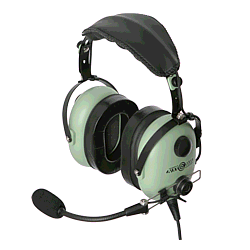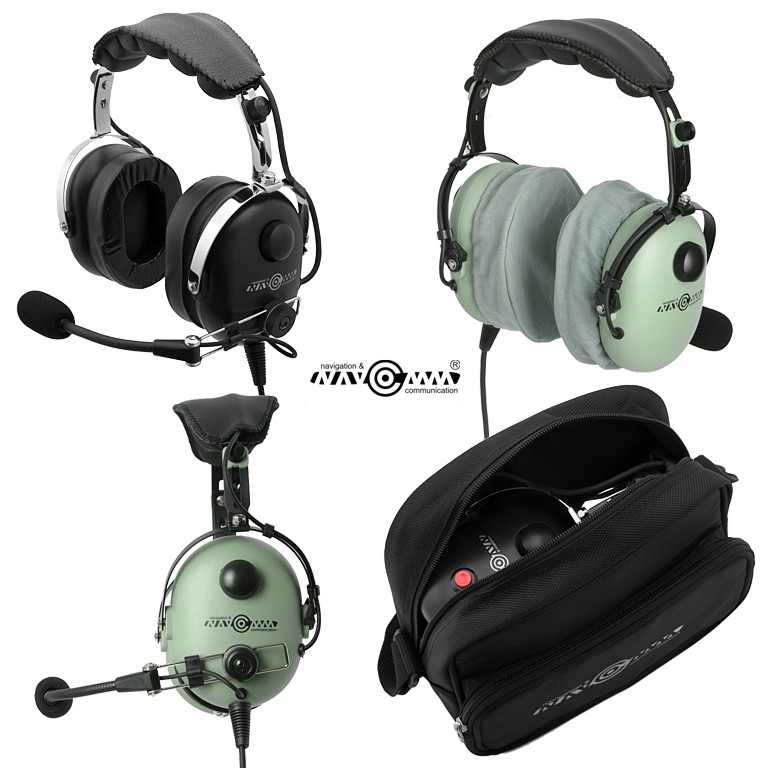PAYMENT OPTIONS:

VALUATION:


CARRIER:
![]()

Introduction »PILOTS EQUIPMENT»Pilot headset»NavComm » Aviation headset NC-1000 ANR
Model NC1000-ANR is the next stage of technology development company NAVCOMM. After a series of passive aviation headsets came time to design with active electronics. Built-in headphone module NC1000ANR ANR (Active Noise Reduction) in a way which allows for passive solutions to reduce the external noise level, and mainly in the low frequencies that are most burdensome to the ear and the most difficult to reduce using only the shielding shell.
Construction external NC1000ANR model does not differ significantly from our earlier models, and consists of: shielding shell (available in two colors: gray-green and black), equipped with gel seals, plus cotton pads (random color), the steel headband with adjustable circumference and soft finish top of a microphone mounted on the arm of a "goose neck", and the mounting arm of the shell equipped with a mechanism for jumping allows precise setting of the microphone in the desired position. In addition, the handset features a półtorametrowy, additional braid reinforced cable terminated connectors standard PJ (PJ052 and PJ068). The end of the cable has a built-in power of ANR - a small box with dimensions of 55x55x20mm located 9V battery, the LED indicating the status of system operation and battery, switch, and a 3.5 mm jack allows hook up an external PTT (Push-To-Talk).
The electronics consists of a passive electret microphone with noise compensation and the frequency response of 100Hz-5kHz, microphone preamp, insert the speaker with an impedance 300 Ohm, and regulating the volume potentiometer. In addition, the earphones electronics module includes active elements ANR.
How does the ANR (Active Noise Reduction) - active noise reduction system
While the principle of operation of headphones with passive damping is not in doubt, the more active noise reduction technology is often little understood phenomenon.
Our experience shows that there are two basic criteria most often driven by customers when choosing aviation headsets - weight, and the effectiveness of noise attenuation. Unfortunately, passive acoustic methods are to some extent the frequency quite limited, which is associated mainly with the following relations:
The absorption coefficient increases with the thickness of the soundproofing material and with increasing frequency of incident acoustic wave at him.
Acoustic waves whose length is comparable to the dimensions of the screen are flexing on its shores, resulting in noise levels on the other side of the screen after using it is a little smaller, and sometimes even larger than before it is installed.
The dependencies stated above indicate that if effective noise reduction in the low frequency earpieces should be of large size and bulky and it would have made it virtually unusable.
Disadvantages of these methods do not have active noise reduction. The basis of these solutions is the use of additional controlled sources. Noise propagates in the form of acoustic waves. The study of wave phenomena, we know that the waves coming from different sources in certain specific conditions, are due to overlapping of mutual compensation. Generating using the previously mentioned additional sources of acoustic wave with appropriate parameters, we use the phenomena of overlapping waves to obtain a noise reduction. In terms of active methods is called the primary source of noise and additional sound sources are called secondary sources.
Active systems installed by us in the NC-1000ANR headphones are composed of interconnected three main components - a reference signal decoder (microphones placed inside the shell), independent for left and right control system shells, and the secondary source (the second insert placed in the shell) . The principle of operation of such a system is to generate the second audio signal pad of the same frequency and same amplitude as the initial signal, but inverted in phase to it. Of course it is also important that the generated signal was confined to secondary importance to the noise sounds. Control of the secondary source must be done in this very high precision, because to get the attenuation above 20 dB sound pressure level difference of primary and secondary wave must be less than 1 dB and phase shift between them should not deviate from 180 ° by more than 5 °. These are the conditions extremely difficult to meet without the use of advanced electronic techniques, respectively, so that P. Lueg method used in its patent application in 1936 became a useful tool in combating noise only with the mastery of advanced digital signal processing techniques.
Technology used by ANR headphones NAVCOMM air has been tested in laboratory conditions using a research methodology developed and described by the U.S. Environmental Protection Agency (EPA) in the document Regulation 40 CFR Part 211th Subpart B (The Range of Noise Reduction Rating for Existing Hearing Protection). As a result of measurement noise ratio (NRR - Noise Reduction Ratings) was set at 24dB, which gives one of the best results among the manufacturers of airline headphone with active damping.
MAJOR FEATURES:
way to reduce noise: passive + active ANR
NNR attenuation: 24dB
ANR attenuation: 23dB
ANR module power supply: 9V battery
ANR system power consumption: 30mW
communication microphone: electret noise-compensated
Microphone Frequency Response: 100Hz - 5kHz
impedance microphone: 150-1000 Ohm
Microphone Sensitivity: -33 + / -4 dB
retention arm microphone: "goose neck" of the step adjustment
powered microphone preamplifier: the aircraft radio installation (8-32V DC)
speaker pads, communication: 30mW (max. 100 mW), ~ 300 ohm
effectiveness of the speaker inserts: 95 + / -5 dB SPL
Temperature range: -20 +70 C
Weight 600g
Kit includes: earphones, cotton caps for shells, 9V battery and carrying bag

